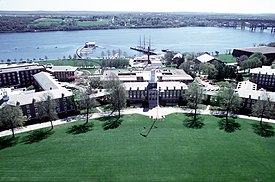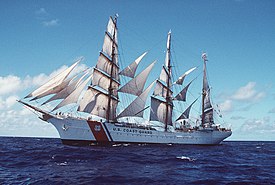|
United States Coast Guard Academy
The United States Coast Guard Academy (USCGA), located in New London, Connecticut, is the U.S. service academy specifically for the United States Coast Guard. Founded in 1876, the academy provides education to future Coast Guard officers in one of nine major fields of study. Students are officers-in-training, and are referred to as cadets. Upon graduation, cadets receive a Bachelor of Science degree and commission in the U.S. Coast Guard as an ensign. In exchange for their debt-free education valued at over $250,000, graduates incur a five-year active-duty service obligation,[Notes 1] with additional years if the graduate attends flight school or subsequent government-funded graduate school. Out of approximately 300 cadets entering the academy each summer, around 250 graduate. Cadets choose from nine majors, with a curriculum that is graded according to their performance in a holistic program of academics, military bearing, physical fitness, character, and leadership. Cadets are required to adhere to the academy's "Honor Concept," "Who lives here reveres honor, honors duty," which is emblazoned in the walls of the academy's entrance. The academy's motto is Scientiæ Cedit Mare, which is Latin for "the sea yields to knowledge". Its academic programs are accredited by the New England Commission of Higher Education.[2] History  The roots of the academy lie in the School of Instruction of the Revenue Cutter Service, the school of the Revenue Cutter Service. The School of Instruction was established near New Bedford, Massachusetts in 1876 and used USRC James C. Dobbin for its exercises. Captain John Henriques served as superintendent from founding until 1883. The one civilian instructor was Professor Edwin Emery, who taught mathematics, astronomy, English composition, French, physics, theoretical steam engineering, history, international law, and revenue law, among other subjects.[3] The school was a two-year apprenticeship, in essence, supplemented by minimal classroom work. The student body averaged five to ten cadets per class. With changes to new training vessels, the school moved to Curtis Bay, Baltimore in 1900 and to Fort Trumbull in 1910, a Revolutionary War–era Army installation in New London, Connecticut. In 1914, the school became the Revenue Cutter Academy, and then the Coast Guard Academy in 1915 with the merger of the Revenue Cutter Service and the United States Life-Saving Service to form the U.S. Coast Guard. Land was purchased in New London on 31 July 1930 for the construction of the Coast Guard Academy. The 40-acre site was made up of two parcels from the Allyn and Payne estates and was purchased for $100,000. The $100,000 was not raised through a bond issue, as originally planned, but with a bank loan based on uncollected back taxes.[4] The contract was awarded to Murch Brothers Construction Company of St. Louis and ground was broken in January 1931 by Jean Hamlet, daughter of Rear Admiral Harry G. Hamlet, Academy Superintendent from 1928 to 1932. On 15 May 1931, Treasury Secretary Andrew W. Mellon visited New London to lay the cornerstone of Hamilton Hall. Construction proceeded relatively on schedule and cadets moved in to the new buildings on 20 September 1932.[4] In 1946, the academy received the barque Horst Wessel as a war reparation from Germany, a 295-foot tall ship which was renamed USCGC Eagle. It remains the main training vessel for cadets at the academy as well as for officer candidates at the Coast Guard's Officer Candidate School, which is located on the grounds of the academy. The academy was racially integrated in 1962 at the request of President Kennedy.[5] The academy began admitting women in 1976 at the request of Congress.[6] In 2018, the academy emblem was redesigned by Nick Desjardins of the Biddeford Regional Center of Technology.[7] Admission Unlike the other service academies, admission to the USCGA does not require a congressional nomination. This is due to the fervent objections of Captain John A. Henriques, the first Superintendent of the Revenue Cutter School of Instruction (later the Revenue Cutter Academy). His objection stemmed from years of poor political appointments in the U.S. Revenue Cutter Service's bureaucracy. Each year more than 2,000 students apply and appointments are offered until the number accepting appointments to the incoming class numbers reaches approximately 400; the average entering class size is 300 cadets.[8] Those who have received appointments as cadets report to the USCGA in late June or early July for "Swab Summer", a basic military training program designed to prepare them for the rigors of their Fourth Class year. After four years of study and training, approximately 250 of those cadets will graduate. About 40 percent of cadets are women. Academics All graduating cadets earn commissions as ensigns in the United States Coast Guard, as well as Bachelor of Science degrees. For that reason the academy maintains a core curriculum of science and professional development courses in addition to major-specific courses. Each cadet takes two semesters of classes during the school year and then spends the majority of the summer in military training to produce officers of character with the requisite professional skills. Among these are courses in leadership, ethics, organizational behavior, and nautical science. The majority of cadets report to their first units after graduating, which are either afloat units, shore units, or basic flight training as student naval aviators, with the training conducted under the auspices of the U.S. Navy. Those that are assigned afloat serve as either deck watch officers or student engineers. Professional maritime studies courses help prepare cadets in piloting, voyage planning, deck seamanship, and all aspects of ship-handling, as well as Coast Guard leadership and administrative duties. MajorsAcademics at the USCGA stress the sciences and engineering, but different courses of study are available. In addition, several of the majors offer tracks of specialization (for example, marine and environmental science majors can choose to focus on biology, chemistry, or geophysics). Cadets sometimes opt to take elective courses with Connecticut College (adjacent the academy's campus) as part of an open exchange agreement.[9] Military training Each summer, cadets participate in training programs according to their class. The summers are organized as follows:[10]
Each week during the school year cadets participate in regimental review, a formal military drill. In addition, cadets perform a variety of military duties at the academy. Like all cadets and midshipmen at the United States service academies, Coast Guard cadets are on active duty in the military and wear uniforms at all times. Cadets receive a monthly stipend to pay for books, uniforms, and other necessities. Cadets receive monthly pay of $1,017.00, as of 2015.[11] From this amount, pay is automatically deducted for the cost of uniforms, books, supplies, services, and other miscellaneous expenses. Organization of the Corps of CadetsThe Corps is organized as one regiment divided into eight companies, each of which is composed of about 120 cadets of all classes. Although the Corps of Cadets is supervised directly by the Commandant of Cadets (a Coast Guard officer with the rank of captain), the academy operates on the concept of "the Corps leading the Corps." The Corps of Cadets is largely a self-directed organization that follows a standard military chain of command:[12]
The highest-ranking cadet in each company is the company commander, a first-class cadet ("firstie"), equivalent to a senior. Although each company has some leeway in their standards and practices, every company commander reports to the regimental staff which plans and oversees all aspects of cadet life. At the top of the cadet chain of command is the regimental commander, the highest ranking cadet. Command positions, both in companies and on regimental staff, are highly competitive, and a cadet's overall class rank is often a deciding factor in who is awarded the position. The eight companies are named for the first eight letters of the NATO phonetic alphabet. Each has a special focus in administering day-to-day affairs: Alfa Company manages health and wellness. Bravo Company runs training. Charlie Company administers the honor system, Delta Company coordinates drill and ceremonies. Echo Company manages transportation and logistics. Foxtrot Company operates the cadet conduct system, organizes the watch rotations, and updates the cadet regulations. Golf Company is in charge of supplies for cleaning and repairing damaged rooms within Chase Hall. Hotel Company is in charge of morale events. To accomplish their missions, each company is divided, along shipboard lines, into three departments, each of which is divided into divisions with specific responsibilities. Divisions are the most basic unit at the Coast Guard Academy, and each has a very specific purpose. Each division is led by a firstie and contains several members of each other class. This organizational structure is designed to give every cadet a position of leadership and to emulate the structure of a Coast Guard cutter, in which the division officer and department head positions are filled by junior officers. Third-class cadets directly mentor the fourth-class in their division, just as junior petty officers would be responsible for the most junior enlisted personnel (non-rates). Second-class cadets act as non-commissioned officers, and ensure that the regulations and accountability are upheld. Firsties (like junior officers) are in supervisory roles, and are responsible for carrying out the mission of their divisions and ensuring the well-being of those under their command. Exchange cadets from the other federal service academies are also a part of the corps, and take part in many activities alongside their USCGA counterparts.[13] Extracurricular activitiesAthleticsThe USCGA Athletic Department offers 24 intercollegiate sports for cadets. The academy's athletics teams generally compete in Division III of the National Collegiate Athletic Association. Cadets devote two hours per academic day to athletic activities, either on varsity teams, club teams, or other sports pursuits. The academy nickname is the Bears, after the USRC Bear, which made a dramatic rescue in Alaska in 1897, shortly after the opening of the academy. MusicPrincipal non-athletic activities are musical centered on Leamy Hall. Regimental Band, Windjammers Drum & Bugle Corps, various pep bands, and the NiteCaps Jazz Band are instrumental programs. Chapel Choirs, Glee Club, the Fairwinds all-female a cappella group, and The Idlers all-male sea shanty group are vocal programs.[14] Model UNThe academy's Model UN team was started in 2004, and has since been successfully competing around North America, and at the World Model UN Conference.[15] PrideThe academy has clubs and teams dedicated to increasing campus morale. These include the cheer squad, dance team and Social Committee.[16] Notable alumniAlumni of the Coast Guard Academy are known collectively as the "Long Blue Line".[17]
Superintendents
U.S. Coast Guard MuseumThe U.S. Coast Guard Museum is located in Waesche Hall on the grounds of the United States Coast Guard Academy. The museum's artifacts reflect the history of the U.S. Coast Guard and include ship models, carved figureheads, cannons, uniforms, medals, weapons, memorabilia and paintings.[75] Visitors must bring a government-issued photo identification to enter the campus, and foreign visitors must make an appointment with the Curator before visiting the museum.[76] See also
Notes
ReferencesNotes
Further reading
External linksWikimedia Commons has media related to United States Coast Guard Academy. |
|||||||||||||||||||||||||||||||||||||||||||||||||||||||||||||||||||||||||||||||||||||||||||||||||||||||||||||||||||||||||||||||||||||||||||||||||||||||||||||||||||||||||||||||||||||||||||||||||||||||||||||||||||||||||||||||||||||||||||||||||||||||||||||||||||||||||||||||||||||||||||||||||||||||||||||||||||||||||||||||||||||||||||||||||||||||||||||||||||||||||||||||||||||||||||||||||||||||||||||||||||||||||||||||||||||||||||||||||||||||||||||||||||||||||||||||||||||||||||||||||||||||||||||||||||||||||||||||||||||||||||||||||||||||||||||||||||||||||||||||||||||||||||||||||||||||

















